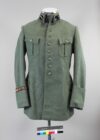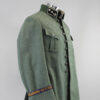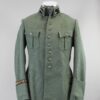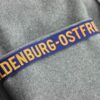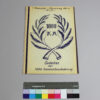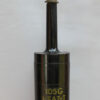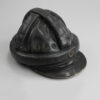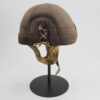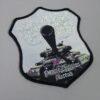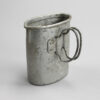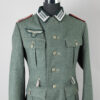Uniform steel helmet waistband
Inventory number: DPM 1.1002
The German steel helmet is one of the central symbols of the First World War. Not all German soldiers were given one, but initially only those who were particularly vulnerable at the front. For the first time, it was the same for all ranks, without regional or decorative markings, and became the symbol of this community of fate in the trenches. A community can only be formed with the exclusion of others: Thus, soldiers who had been deployed at the front for a longer period of time saw themselves as elite front-line fighters and looked down on soldiers in the support units and in the stage.
It is therefore hardly surprising that the Stahlhelm gave its name to a veterans’ association: “Stahlhelm – Bund der Frontsoldaten” or Stahlhelmbund for short. It was one of the most influential and largest military associations in the Weimar Republic and was founded just a few weeks after the end of the First World War. However, the Bund was not a coffee party for old comrades, but a paramilitary organization that wanted to be non-partisan, but was anything but apolitical: its founders wanted to bring together soldiers who wanted to fight against left-wing revolutionaries during the November Revolution. Later, they positioned themselves against the democratic system of the Weimar Republic. Initially only active in the Magdeburg area, the Stahlhelmbund expanded over the course of the 1920s to become a mass organization with members from the former Freikorps and Einwohnerwehren throughout the Reich.
The uniform comes from a member of the “Oldenburg-Ostfriesland” district. It is not just a coincidence that it is reminiscent of the field-grey uniforms of the Imperial Army: the abolition of compulsory military service and the dissolution of many garrisons in Germany separated the population and the military, which had still been closely interwoven during the imperial era. Organizations such as the Stahlhelmbund brought former soldiers back into the mainstream of society.
The uniformed members organized cultural events and were firmly anchored in the nationally-minded middle classes. Due to the provisions of the Treaty of Versailles limiting the Reichswehr to 115,000 men, many former soldiers were excluded from serving in the armed forces, and in the Stahlhelmbund they were able to build on their social position in the imperial era and find like-minded people who blamed the Social Democrats and Jews for the lost war. With this conspiracy narrative, the front-line soldiers were able to deflect attention from their own responsibility and cultivate the myth that the imperial army had lost the war but was “undefeated in the field”. Consequently, only a few Social Democrats and Jews were members of the Stahlhelmbund, and from 1924 the Stahlhelmbund added an “Aryan paragraph” to its statutes and forced Jewish front-line soldiers to resign.
Ideologically, the Stahlhelmbund offered many points of contact with the National Socialists, but they also saw themselves in competition with each other. The founder and federal leader of the Stahlhelmbund, Franz Seldte, sealed the fate of the organization when he became Reich Labour Minister in 1933, joined the NSDAP and voted for Hitler’s Enabling Act. The dissolution of the federation and the personal merger with the National Socialists was finalized when the almost one million Stahlhelm members were transferred to the NSDAP’s paramilitary organization, the SA, in 1935. Those who resisted this “voluntary” transfer had to swear an oath to Hitler and were grouped together in the “National Socialist German Front Fighters’ League” instead of the SA, which was, however, disbanded at the end of 1935.
Object of the month
(short) stories from the depot
Unfortunately, many objects cannot currently be shown in the exhibition for conservation reasons. Here you will find unusual objects and exciting stories of special pieces from the depot
